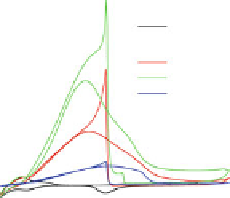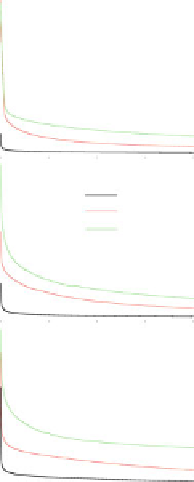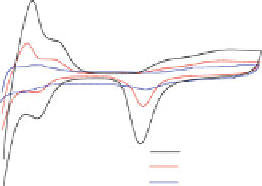Environmental Engineering Reference
In-Depth Information
(a)
0.16
(c)
400
0.14
0.12
200
0.10
0.08
0
0.06
-200
0.04
0.02
-400
Pd-25
Pd-100
Bulk Pd(x5)
4.0
(d)
3.5
-600
bulk Pd
Pd-25/GC
Pd-100/GC
3.0
-0.4
-0.2
0.0
0.2
0.4
0.6
0.8
1.0
2.5
2.0
E (V vs Ag/AgCl)
1.5
(b)
1.0
7
0.5
6
Pd-25/GC
in 0.1M HClO
4
Pd-25/GC
Pd-100/GC
bulk Pd
0.0
(e)
5
1.0
4
0.8
3
0.6
2
0.4
1
0.2
0
0.0
0
100
200
300
400
-0.4 -0.2 0.0
0.2
0.4
0.6
0.8
1.0
1.2
1.4
t (s)
E(V vs Ag/AgCl)
Fig. 19 a Cyclic voltammograms of the PdAg-25/GC (black curve), PdAg-100/GC (red curve),
and bulk Pd electrode (blue curve) in 0.1 M HClO
4
solution. For comparison, the CV from the Pd
bulk electrode is magnified 59. b CVs of the PdAg-25/GC (red curve), PdAg-100/GC (green
curve), and bulk Pd electrode (blue curve) electrodes in 0.1 M HClO
4
and 0.5 M HCOOH
solution and the CV of PdAg-25/GC (black curve) in 0.1 M HClO
4
. Potential scan rate 0.1 V s
-1
.
Chronoamperometric curves of the bulk Pd, PdAg-25/GC and PdAg-100/GC electrodes in 0.1 M
HClO
4
+ 0.5 M HCOOH at different electrode potentials: c -0.15, d +0.3, and e +0.68 V.
Reprinted from Ref. [
76
] with permission by the American Chemical Society
show that worm-like nanowires were formed and the surface of the nanowires is
predominated by Pd(111) planes. As mentioned previously, the (111) planes of Pd
are less susceptible to oxidation and have a lower peak potential for formic acid
oxidation, making the nanowires promising electrocatalysts for DFAFCs. The
element maps revealed that the elements of Pd and Ag are homogeneously dis-
persed in the PdAg nanowires, indicating the formation of alloy structure. The
electrochemical studies showed that although the onset potential of formic acid
oxidation on PdAg nanowires is only a little more negative than that on the
commercial Pd/C catalyst, the current density of formic acid oxidation in both
forward and reverse potential sweeps is much larger (about 3.4 times) than that
obtained at the Pd/C. Moreover, from the CV and chronoamperometric mea-
surements,
our
synthesized
PdAg
nanowires
exhibit
high
CO
tolerance
and




















































































Search WWH ::

Custom Search